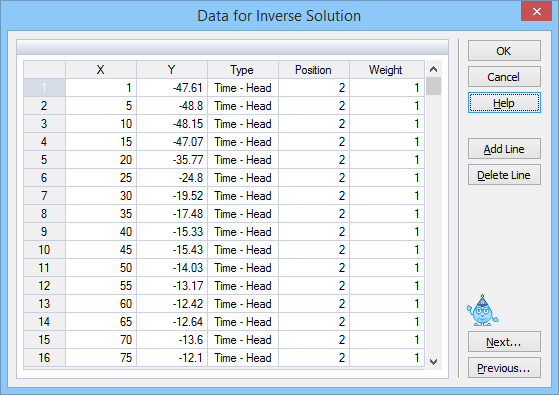In the table Data for Inverse Solution one specifies the measured data that will be analyzed during the parameter optimization process. Many different types of data can be used to define the objective function that will be minimized for this purpose. How the values in the X and Y columns are interpreted depends on the Type and Position values. Weight is the weight associated with a particular data point. The following information can be included into the objective function:

The Data for Inverse Solution dialog window.
Data Types for the objective function (Inverse Problem).
Type |
Data Point |
0 |
Cumulative boundary fluxes across a specified boundary |
1 |
Pressure head measurements at selected observation point(s) |
2 |
Water content measurements at selected observation point(s) |
3 |
Boundary flux across a specified boundary |
4 |
Concentration or temperature measurements at observation point(s) |
5 |
h(θ) measurements; soil water retention data |
6 |
K(h) measurements; hydraulic conductivity data point |
7 |
Prior knowledge of parameter α |
8 |
Prior knowledge of parameter n |
9 |
Prior knowledge of parameter θr |
10 |
Prior knowledge of parameter θs |
11 |
Prior knowledge of parameter Ks |
Depending upon the value of parameter Type, the first column (X) contains the following information:
Definition of the column X based on Data Type (Inverse Problem).
X |
Type |
Time |
0, 1, 2, 3, 4 |
Pressure head |
5, 6 |
Dummy variable |
7, 8, 9, 10, 11 |
Depending upon the value of parameter Type, the second (Y) and fourth (Position) columns contain the following information:
Definition of the column Y based on Data Type (Inverse Problem).
Y |
Type |
Position |
Cumulative boundary flux across a specified boundary |
0 |
Code for the specified boundary* |
Pressure head |
1 |
Observation node number |
Water content |
2 |
Observation node number |
Averaged water content of the entire flow domain |
2 |
0 |
Averaged water content of the subregion |
2 |
Negative subregion number |
Concentrations/temperatures |
4 |
Observation node number |
Concentrations for the second solute |
4 |
Negative observation node number |
Total amount of solute in the entire flow domain |
4 |
0 |
Boundary flux across a specified boundary |
3 |
Code for the specified boundary* |
Water content |
5 |
Material number |
Hydraulic conductivity |
6 |
Material number |
Particular parameter |
7-11 |
Material number |
*1 – constant pressure head or flux boundary; 2 – seepage face; 3 – variable pressure head or flux boundary 1; 4 – atmospheric boundary; 5 – drains; 6 – free or deep drainage boundary; 7, 8, and 9 – variable pressure head or flux boundaries 2, 3, or 4, respectively.
Definition of the objective function and some statistics associated with the inverse solution are give in the Objective Function and Statistics topic.